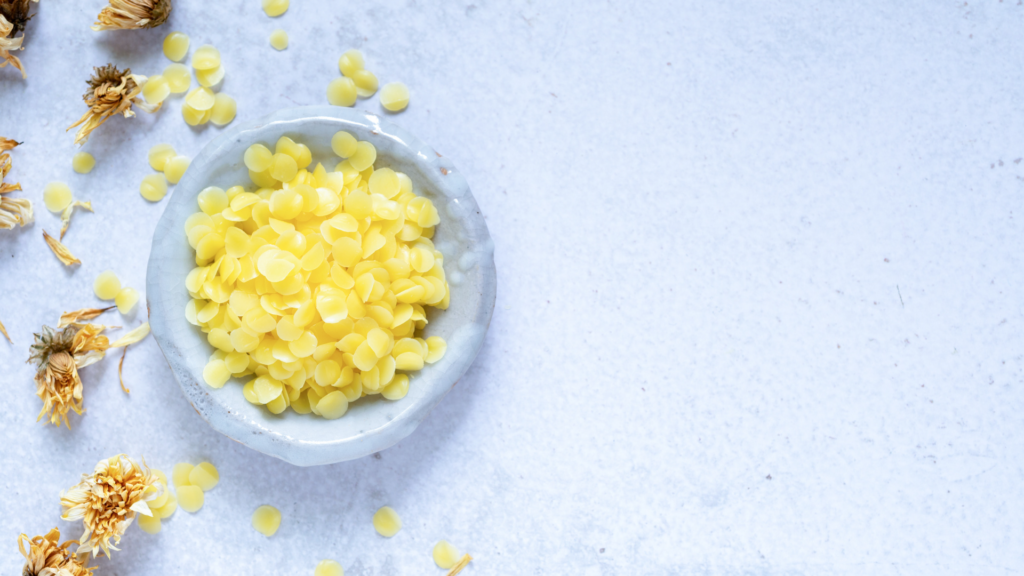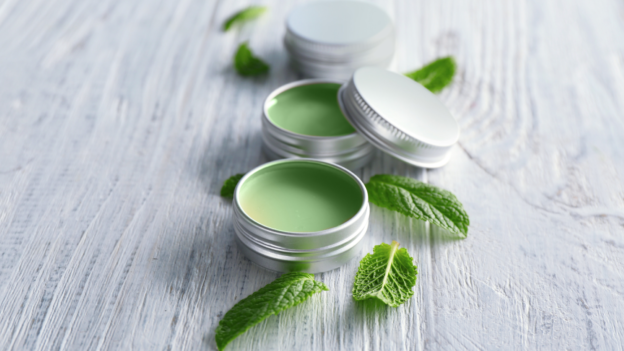I’m often called upon to help someone with balm formulations. Balms (thickened mixtures of oils) can be very simple and attractive products. Normally, a balm can be made with something as simple as 80% oils and 20% beeswax. Heat is applied until the beeswax melts, and then once the sample cools the product solidifies. However, this often doesn’t give the best texture. Beeswax balms can be stiff and hard to the touch. Trying to lower the amount of beeswax downwards often results in an uneven texture. They tend to be “grainy”, where crystallized particles can be found in the finished product. This is especially true if any natural butters (shea, mango) are also in the formula.
These crystallite formations are normally the result of free fatty acids in beeswax / natural butters joining together into a dimer. Beeswax contains about 20% free fatty acids. Once the beeswax is molten, they’re free to roam around. The hydrophilic (“water-loving”) heads of the fatty acid molecules can find a partner fatty acid, and interact to form a carboxylic acid dimer, which is twice as long. More importantly, it has a more crystalline character than normal. Once the material cools, these crystalline dimers form the fine grit that can appear in simple beeswax balms. There are some tricks you can play with temperature; cooling the product as quickly as possible will hopefully “freeze out” the beeswax before the dimers can form. That’s not easy to accomplish. You need lots of refrigeration dedicated to cooling cosmetic products.
Whenever someone approaches me with a gritty balm – especially if they’re looking for a hydrating product – I always give them the same suggestion: Cera Bellina.

Cera Bellina is a relatively new ingredient in cosmetics. It’s made from vegetable glycerin and white beeswax. The two ingredients are heated together until molten (with a trace of acid catalyst), and then cooled again. There is a reaction that occurs, and the glycerin attaches to the beeswax fatty acids; the two can no longer be separated. This produces a new wax, with the INCI name “Polyglyceryl-3 beeswax”. It comes in the form of white pellets, just like beeswax, and has a higher melting point (80C vs 60C). It dramatically changes the thickening properties of the beeswax.
Normally using a higher melting point wax results in a balm that is harder / more brittle. That’s the behavior seen moving from beeswax to candelilla to carnauba. Cera Bellina is an exception. Instead of “setting up” into a hard balm that’s grainy, using 20% Cera Bellina and 80% oils results in a much different texture. You stir during the cooldown phase, and the result is a glorious goopy ointment. It has a wonderful “skin feel” – non-tacky, very smooth, soft, unctuous, luxurious, and extremely hydrating. Unless you’ve tried a Cera Bellina product before, it’s probably not a skin feel you’ve experienced.
Not only does the ingredient serve as an occlusive for the top layer of skin (to help prevent trans-epidermal water loss, or TEWL) but it also serves as a humectant. The glyceryl section of the molecule pulls water molecules towards it, almost like the behavior of a magnet. The result is more moisture in the skin with a much lesser sense of grittiness. This helps the anhydrous product address multiple causes of dry skin at once, making it a powerful moisturizing agent.
The Cera Bellina can also be used in combination with beeswax. The combination of beeswax and Cera Bellina in various ratios (equaling 20%) results in a harder product that can be great for lip balms and “rub-in” soft balms. You still see the protection against the grainy texture and have some increased hydration, only with a slightly firmer end result.
The one caution about using Cera Bellina is that it can attract water to the material in the container, giving potential microbes access to one of the key factors they need to multiply. However, this downside can be counteracted by the addition of an ingredient I’ve written about before – the Phytocide Elderberry OS broad-spectrum preservative. That, plus an antioxidant like vitamin E or rosemary oleoresin, completes the product.
If you’re looking for an additive that can give both fun and functional properties to your balms and salves, try out Cera Bellina! It’s available from multiple vendors, including Lotion Crafter. There’s nothing else quite like it and may become a valuable tool in your formulating toolbox.

